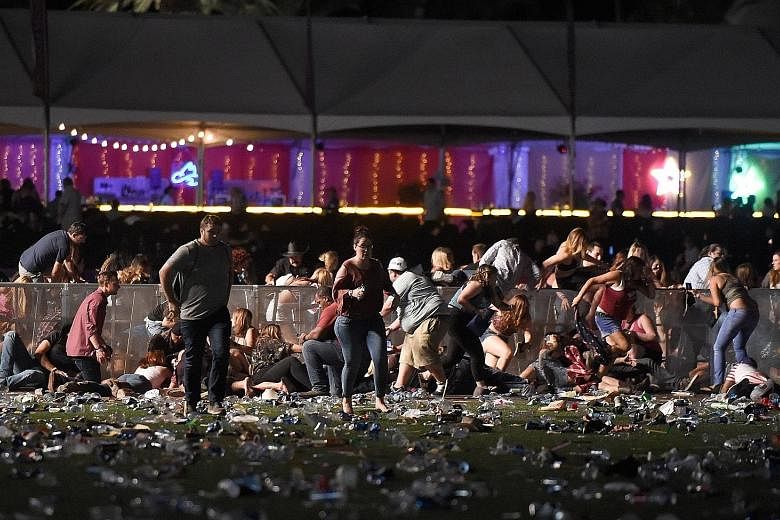LAS VEGAS • In the aftermath of the mass shooting at the Las Vegas country music festival, security professionals have a new threat to worry about - aerial assaults.
The spectre of calamity is especially worrisome for open-air events in urban environments - including the Austin City Limits music festival, which begins tomorrow in a Texas park and is now undergoing renewed security assessments.
"There is no manual for this," said Mr Chris Robinette, president of Prevent Advisors, which works with sports and entertainment venues on security issues.
"It is a dynamic process that requires promoters, venue managers, the local authorities and other stakeholders to work together."
Ever since the Sept 11 attacks in 2001, standard security protocol at concerts, festivals and other large entertainment events has become increasingly sophisticated.
Music gatherings have become the site of bomb-sniffing dogs, body scanners and high-definition closed-circuit cameras, particularly amid a backdrop of recent large-scale attacks on the Bataclan rock club in Paris and the Manchester Arena.
But even with the gradual ratcheting up of protection measures, a new wave of mass-casualty events has highlighted the ways determined attackers can wreak havoc by shifting their focus to the areas immediately surrounding a venue.
In Las Vegas, the gunman executed his killing spree from a window at the Mandalay Bay Resort and Casino - about 365m away from the festival site - well outside the usual security perimeter of pat-downs and metal detectors.
He slipped through the hotel's own security apparatus and chose an open-air target that is by definition vulnerable from a high elevation.
Mr Louis Marciani, director of The National Center for Spectator Sports Safety and Security, said: "There's no way that any good operation would have caught that. We've now got to go back to the drawing board."
Las Vegas Village, the site of the Route 91 Harvest Festival, is owned by the same company - MGM Resorts International - as the hotel where the gunman opened fire.
It is likely that there was at least some pre-planning between the two facilities before the festival took place.
But even if Mandalay Bay was on high alert last weekend, snaring the gunman would likely have required a level of screening that far exceeds current practices. "You'd have to have X-ray machines and magnetometers at every single entrance," said Mr Steven Adelman, vice-president of the Event Safety Alliance.
"No hotel does that."
Festival organisers could choose to avoid locations near tall buildings that can offer gunmen cover and a clear vantage but he suggested that other loopholes would then emerge. "Do you not hold festivals near hills or tall trees?"
Mr Jeff Dorenfeld, a music business professor at Berklee College of Music, offered a similarly rueful hypothetical: Does every festival now have to be like Bonnaroo Music and Arts Festival in Manchester, Tennessee - "in the middle of an open field?"
For the people behind Austin City Limits, which will bring 75,000 music fans to Zilker Park in Austin, Texas, this weekend, the question of how to keep people safe is now freighted with even more pressing urgency than usual.
Following the Las Vegas shooting, the producer of the Austin festival, C3 Presents, released a statement detailing a "layered security plan that includes elements that are seen and unseen" and that will include "an enhanced security and law-enforcement presence inside and outside the festival".
Austin police chief Brian Manley said on Monday: "It's not that it's a threat that we are not aware of, but whenever you have an incident occur, you always have to be concerned about copycats - someone that looks at this as an opportunity."
He added that police officers had already visited condominiums on the park's north side that partly overlook the festival grounds.
But he ended the news conference with an unvarnished caveat.
"We live in a world now where you cannot protect against every single threat," he said.
NYTIMES

